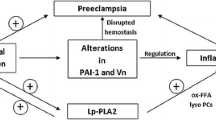Summary
The present study examined von Willebrand factor (vWF) levels and ADAMTS13 activity in pregnant and severe preeclamptic women in order to shed light on the prothrombotic state in severe preeclampsia. Thirty healthy women of childbearing age, 22 second trimester pregnant women, 30 third trimester pregnant women and 10 severe preeclamptic patients were recruited in this study. ADAMTS13 activity was determined by the FRETS-vWF73 assay and vWF antigen (vWF:Ag) levels by an enzyme-linked immunosorbent assay. The results showed that there were statistically significant differences in plasma vWF antigen levels between the severe preeclamptic and third trimester pregnant women, between third and second trimester pregnant women (P<0.05). The third trimester pregnant women had significantly lower plasma ADAMTS13 activity than second trimester pregnant women (P<0.05). Nevertheless, no significant differences in plasma ADAMTS13 activity were found between severe preeclamptic patients and the third trimester pregnant women (P>0.05). In conclusion, plasma ADAMTS13 activity is normal in severe preeclampsia despite the increased vWF:Ag levels. Prothrombotic state is involved in the pathogenesis of severe preeclampsia, as a result of endothelial injury.
Similar content being viewed by others
References
Sadler JE, Moake JL, Miyata T, et al. Recent advances in thrombotic thrombocytopenic purpura. Hematologyo (Am Soc Hematol Educ Program), 2004, 2004(1):407–423
Fujikawa K, Suzuki H, McMullen B, et al. Purification of human von willebrand factor-cleaving protease and its identification as a new member of the metalloproteinase family. Blood, 2001,98(6):1662–1666
Molvarec A, Rigo J, Boze T, et al. Increased plasma von Willebrand factor antigen levels but normal von Wille brand factor cleaving protease (ADAMTS13) activity in preeclampsia. Thromb Haemost, 2009,101(2): 305–311
Mannucci PM, Canciani MT, Forza I, et al. Changes in health and disease of the metalloprotease that cleaves von Willebrand factor. Blood, 2001,98(9):2730–2735
Furlan M, Lammle B. Assays of von Willebrand factor-cleaving protease: a test for diagnosis of familial and acquired thrombotic thrombocytopenic purpura. Semin Thromb Haemost, 2002,28(2):167–172
Rick ME, Moll S, Taylor MA, et al. Clinical use of a rapid collagen binding assay for von Willebrand factor cleaving protease in patients with thrombotic thrombocytopenic purpura. Thromb Haemost, 2002,88(4): 598–604
Kokame K, Matsumoto M, Fujimura Y, et al. vWF73, a region from D1596 to R1668 of von Willebrand factor, provides a minimal substrate for ADAMTS-13. Blood, 2004,103(2):607–612
Kokame K, Nobe Y, Kokubo Y, et al. FRETS-vWF73, a first fluorogenic substrate for ADAMTS13 assay. Br J Haematol, 2005,129(1):93–100
Raife TJ, Cao W, Atkinson BS, et al. Leukocyte proteases cleave von Willebrand factor at or near the ADAMTS13 cleavage site. Blood, 2009,114(8):1666–1674
Shankaran H, Alexandridis P, Neelamegham S. Aspects of hydrodynamic shear regulating shear-induced platelet activation and self-assocaition of von Willebrand factor in suspension. Blood, 2003,101(7):2637–2645
Andrews RK, Berndt MC. Platelet physiology and thrombosis. Thromb Res, 2004,114(5–6):447–453
Donadelli R, Orje JN, Capoferri C, et al. Size regulation of von Willebrand factor-mediated platelet thrombi by ADAMTS13 in flowing blood. Blood, 2006,107(5):1943–1950
Oleksowicz L, Bhagwati N, DeLeon-Fernandez M. Deficient activity of von Willebrand’s factor-cleaving protease in patients with disseminated malignancies. Cancer Res, 1999, 59(9):2244–2250
George JN. The association of pregnancy with thrombotic thrombocytopenic purpura—hemolytic uremic syndrome. Curr Opin Hematol, 2003,10(5):339–344
Mariarosaria I, Patrizia S, Antonio DA, et al. A post-partum hemolytic-uremic-like-syndrome in a patient with pre-eclampsia: Description of a clinical case. Transfus Apher Sci, 2006,34(1):11–14
McMinn JR, George JN. Evaluation of women with clinically suspected thrombotic thrombocytopenic purpura—hemolytic uremic syndrome during pregnancy. J Clin Apheresis, 2001,16(4):202–209
Hulstein JJ, Van Runnard Heimei PJ, Franx A, et al. Acute activation of the endothelium results in increased levels of active von Willebrand factor in hemolysis, elevated liver enzymes and low platelets (HELLP) syndrome. Thromb Haemost, 2006,4(12):2569–2575
Furlan M, Robles R, Galbusera M, et al. von Willebrand factor-cleaving protease in thrombotic thrombocytopenic purpura and the hemolytic-uremic syndrome. N Engl J Med, 1998,339(22):1578–l584
Tsai HM, Lian EC. Antibodies to von Willebrand factor- cleaving protease in acute thrombotic thrombocytopcnic purpura. N Engl J Med, 1998,339(22):1585–1594
Mahdian R, Rayes J, Girma JP, et al. Comparison of FRETS-vWF73 to full-length vWF as a substrate for ADAMTS13 activity measurement in human plasma samples. Thromb Haemost,2006,95(6):1049–1051
Nishio K, Anderson PJ, Zheng XL, et al. Binding of platelet glycoprotein Iba to von Willebrand factor domain A1 stimulates the cleavage of the adjacent domain A2 by ADAMTS13. Proc Natl Acad Sci USA, 2004,101(29), 10578-10583
Zhuang X, Ha T, Kim HD, et al. Fluorescence quenching: A tool for single—molecule protein-folding study. Proc Natl Acad Sci USA, 2000,97(26):14241–14244
Zhang L, Lawson H, Harish V, et al. Creation of a recombinant peptide substrate for fluorescence resonance energy transfer-based protease assays. Anal Biochem, 2006,358(2): 298–300
Author information
Authors and Affiliations
Corresponding author
Additional information
This project was supported by grants from National Natural Sciences Foundation of China (No.30672243, No.30671093) and Natural Sciences Foundation of Hubei Province (No. ZR-Y1271).
Rights and permissions
About this article
Cite this article
Zhang, D., Xiao, J., Huang, H. et al. Von Willebrand factor antigen and ADAMTS13 activity assay in pregnant women and severe preeclamptic patients. J. Huazhong Univ. Sci. Technol. [Med. Sci.] 30, 777–780 (2010). https://doi.org/10.1007/s11596-010-0657-4
Received:
Published:
Issue Date:
DOI: https://doi.org/10.1007/s11596-010-0657-4




